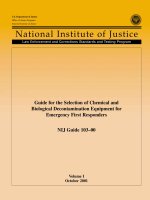we called it mag-nificent dow chemical and magnesium, 1916-1998
Bạn đang xem bản rút gọn của tài liệu. Xem và tải ngay bản đầy đủ của tài liệu tại đây (389.71 KB, 171 trang )
WE CALLED IT
MAG- NIFICENT
WE CALLED IT
MAG- NIFICENT
Dow Chemical and Magnesium, 1916– 1998
E. N. Brandt
Michigan State University Press
East Lansing
Copyright © 2013 by E. N. Brandt
iThe paper used in this publication meets the minimum requirements of ANSI/
NISO Z39.48- 1992 (R 1997) (Permanence of Paper).
Michigan State University Press
East Lansing, Michigan 48823- 5245
Printed and bound in the United States of America.
19 18 17 16 15 14 13 1 2 3 4 5 6 7 8 9 10
library of congress cataloging- in- publication data
Brandt, E. N.
We called it mag- nificent : Dow Chemical and magnesium, 1916– 1998 / by
E. N. Brandt.
pages cm
Includes bibliographical references and index.
ISBN 978- 1- 61186- 075- 7 (cloth : alk. paper)— ISBN 978- 1- 60917- 363- 0
(ebook) (print) 1. Dow Chemical Company— History. 2. Magnesium industry
and trade— United States. I. Title.
HD9539.M28D683 2013
338.7'66967230973— dc23
2012028148
Book design by Charlie Sharp, Sharp Des!gns, Lansing, Michigan
Cover design by John Barnett, www.4eyesdesign.com
Cover image is used courtesy of the Chemical Heritage Foundation Collections.
G
Michigan State University Press is a member of the Green Press Initiative
and is committed to developing and encouraging ecologically responsible
publishing practices. For more information about the Green Press Initiative and the
use of recycled paper in book publishing, please visit www.greenpressinitiative.org.
Visit Michigan State University Press at www.msupress.org
For H. D. (Ted) Doan
Friend and Mentor
Contents
1 Star Shells . . . . . . . . . . . . . . . . . . . . . . . . . . . . . . . . . . . . . 1
2 Dowmetal Pistons and the Indy 500 . . . . . . . . . . . . . . . 13
3 Willard and the Gondolas . . . . . . . . . . . . . . . . . . . . . . . 27
4 Dow Goes Down to the Sea . . . . . . . . . . . . . . . . . . . . . . 37
5 How to Make Magnesium out of Seawater . . . . . . . . . . 49
6 Two- Faced Government . . . . . . . . . . . . . . . . . . . . . . . . . 55
7 The Hanawalt Era. . . . . . . . . . . . . . . . . . . . . . . . . . . . . . 71
8 The Hazards of Coastal Texas . . . . . . . . . . . . . . . . . . . . 81
9 Hot Stuff . . . . . . . . . . . . . . . . . . . . . . . . . . . . . . . . . . . . . 91
10 Mag Mountain . . . . . . . . . . . . . . . . . . . . . . . . . . . . . . . 105
11 The Nineteen- Seventies . . . . . . . . . . . . . . . . . . . . . . . . 111
12 Havoc in the Marketplace . . . . . . . . . . . . . . . . . . . . . . 121
13 A Non- Event . . . . . . . . . . . . . . . . . . . . . . . . . . . . . . . . . 131
Notes . . . . . . . . . . . . . . . . . . . . . . . . . . . . . . . . . . . . . . . . . . . 139
Sources and Acknowledgments . . . . . . . . . . . . . . . . . . . . . . 149
Index . . . . . . . . . . . . . . . . . . . . . . . . . . . . . . . . . . . . . . . . . . . 155
Magnesium Metal
Symbol— Mg
Atomic weight— 24.305
Melting point— 1204 F
The lightest commercial metal, one- third lighter than aluminum. Silvery
white color. Oxidizes and tarnishes in moist air, but is stable in dry air. In
finely divided form can be ignited and burns with an intense white light,
but in solid form is permanent and must be heated above the melting
point before it will burn.
— FROM A CHEMISTRY TEXTBOOK
1
Star Shells
Star Shells
3
W
hile he was pondering what he read in his newspa-
per, one day during the grim early days of World
War I, before the United States entered that con-
flict, Herbert Dow hatched out an idea. Dow, founder of The
Dow Chemical Company, had a new idea just about every day,
so that wasn’t unusual, but this idea was special, and it was
to play a major role in the life of his company for the next
eighty- three years.
Magnesium metal was suddenly and unexpectedly in heavy
demand because of the war, the newspaper said. A new kind of
war was going on in Europe. It was called “trench” warfare, in
which each of the belligerents dug a deep trench in which it
sheltered the troops on its side of the battle line, and the war
ground to a standstill for weeks and months while the two foes
glared at each other across “No Man’s Land,” as they called
the area between the opposing lines of trenches. Occasionally
one side or the other would leap from its trenches and charge
“over the top” in a murderous and often suicidal assault on
the opposing trenches. It rained steadily, and the terrible deep
mud that resulted bogged down the opposing forces on these
fronts even more. The newspaper noted the growing use of
pyrotechnics to light up the corridor between the two lines
of trenches, the better to prevent surprise attacks in the night-
time. Some nights, the newspaper said, “No Man’s Land” was
lit up with the eerie light of star shells for hours at a time.
It was the pyrotechnics that sparked off his thinking. These
were magnesium flares incorporated in a rocket device com-
monly called a star shell. A star shell would be fired into the sky
from the trenches and would burst at a given height, igniting
a magnesium flare and activating a parachute, usually made of
fine Japanese silk. The burning flare would slowly drift back to
earth under the parachute, taking about six to ten minutes
to do so, and lighting up a portion of No Man’s Land as it
descended.
He also read about the introduction of tracer bullets, which
showed where your bullets were going in the darkness, and
about the invention of the Very pistol, used to pass pyrotech-
nic signals along the often extended reaches of the trenches,
4
Chapter One
both of which also employed magnesium. With all of these
devices using magnesium, it became clear to him that if, or
when, the United States entered the war (as it eventually did in
April 1917), or even if it didn’t, there was a rapidly escalating
demand for magnesium metal as a result of this war.
“We have more magnesium chloride than we know what to
do with” he told E. O. (Ed) Barstow, one of his top lieutenants,
explaining his idea. It was one of the chief components of the
brines underlying central Michigan, which were then the main
source of his chemical raw materials. “If we could separate out
the magnesium metal we could provide one of the things this
country is going to need for the war, and we could use the
chlorine we liberated in doing so to make other products.”
1
Barstow was immediately enthusiastic about the idea, and the
two men began to puzzle out how they might go about produc-
ing magnesium metal in Midland from the liquid brine they
were pumping from the ground.
They knew that the renowned German chemist Robert
Wilhelm Bunsen, Baron von Bunsen, had succeeded in pro-
ducing magnesium metal by electrolysis— the first to do so— in
Germany, back in 1852.
2
Barstow, who was in charge of the
Dow cell buildings— the buildings that housed the electro-
lytic cells— began to put together a cell that might duplicate
Bunsen’s achievement, but it was slow work and turned out
not to be a spare- time job. Indeed, it turned out that Barstow
would spend twenty- seven years working on magnesium and
be remembered as “the father of magnesium,” but they didn’t
know that at the time.
Herbert Dow’s first recorded experiment with a magne-
sium compound went back to February 1896, when he worked
out a method for making magnesium hydrate— “milk of
magnesia”— from the brine stream at Midland. By 1914 and
the onset of World War I, he was manufacturing four different
magnesium compounds from the brine— magnesium sulfate,
or Epsom salts; magnesium hydrate, or milk of magnesia; mag-
nesium oxychloride, used in flooring and stucco work; and
magnesium chloride, used in cement and also the potential
source of magnesium metal.
Star Shells
5
Dow and Barstow discussed the problem of making mag-
nesium metal from the brine many times in those days before
the United States entered the war, and they decided this
would be a great challenge to put before Prof. W. R. Veazey,
of the Case Institute (now Case- Western Reserve University) in
Cleveland. Veazey was in the habit of coming up to Midland to
do chemical research during the summer term, when the Case
school was mostly closed down, and when he came in 1916,
Dow and Barstow had already told him what they wanted him
to work on that summer— the production of magnesium metal
from magnesium chloride via electrolysis.
The basic problem, Veazey soon found, was that when
subjected to electrolysis in the rather crude cell they had put
together (made of welded boiler plate and soapstone slabs),
they got small globules of magnesium to bubble up from the
magnesium chloride cell feed, but could not get them to
coalesce, or join together, in a mass. Herbert Dow, looking at
the problem, told them he wanted to see not those globules,
but “one pound of magnesium in one piece.”
Prof. Veazey, who later became a full- time Dow employee,
had brought a Case student with him that summer, William
R. Collings (who later became founding president of the Dow
Corning Corporation), and they were joined by Edward C.
Burdick, who had been working with Barstow on the problem,
and I. J. (Charley) Stafford, a veteran of Dow’s cell operations.
Veazey was in charge of operations, Stafford prepared the cell
feed (anhydrous, or dry, magnesium chloride), and Burdick
was in charge of running the cell.
The first cell, Burdick said, was a square box “welded out of
boiler plate about 8 inches by 12 inches by 6 inches, lined with
slabs of soapstone, and a soapstone partition divided the box
into two halves at the top, leaving the lower part of the interior
cavity open for the whole length. An iron plate was inserted in
one half of the box and a graphite electrode in the other, and
the two electrodes connected with a source of direct current
from a low voltage generator.”
3
“This crude cell was heated up in an improvised brick
arch by a charcoal fire until it was thoroughly hot, then some
Chapter One
6
molten magnesium chloride was poured in and the current
turned on.”
The first run of the cell was started late one afternoon on
“one of the hottest days of the hottest summer he had ever
experienced in Midland,” Burdick said. “Much to our surprise,
the cell actually ‘ran’ when it was first started and began to pro-
duce some magnesium metal which, after a time, appeared as
those small globules floating around in the molten salt bath.”
The salt bath was maintained in molten condition “at about a
bright red heat.”
“After having got this cell started we kept it going all night
and the next morning when Mr. Barstow appeared we were
able to present him with a flat pancake of magnesium which
had been dipped out of the cell weighing about one pound. This
was practically the first magnesium made in the Dow Plant.”
That left the main problem to be solved, getting the glob-
ules to coalesce, and they set to work on it.
As Veazey described it later, success came rather unexpect-
edly on July 28, 1916, another scorching hot day in Midland,
two months after they had started. It was the “night shift”
(Veazey and Burdick) who hit the jackpot. They decided to
try electrolyzing a fused salt bath that evening, and it worked.
4
The globules joined together in a mass. “We had been work-
ing at such a determined pace on the problem of getting the
small pieces of magnesium to coalesce that when we finally
succeeded in getting one whole piece, we suddenly realized
nobody had thought about how to cast it or get it out of the
cell,” he said. “Somebody grabbed the first thing he could find,
which was a piece of sheet iron. It was heated and bent into
the shape of a crude ladle. A piece of pipe was attached for a
handle and the piece of magnesium metal was scooped out of
the magnesium bath. There was no mold, so we set the ladle
on the floor to let the magnesium cool. And that’s how we got
the first ingot of magnesium.”
5
That afternoon, Herbert Dow dashed off a note to his close
friend Prof. A. W. Smith at Case. (They had been fellow stu-
dents at Case, and Smith was now the head of the school’s
chemistry department and a member of Dow’s board of
Star Shells
7
directors.) “Dr. Veazey brought in a nugget of metallic magne-
sium this noon weighing about six ounces,” he wrote. “He said
they worked last night until one o’clock and he thought at that
time that he wouldn’t get down today until about noon, but he
couldn’t stay away. They refined the metal this morning and
obtained a nugget of which this is the outline.” The nugget
was about the size of a small hamburger patty, three inches in
diameter and an inch- and- a- quarter thick.
6
Herbert Dow took this first sizable lump home to show his
family, even though it didn’t weigh a pound. “Someday this will
be the biggest thing we have,” he told them. He put another
piece on display in the window of Bert Carter’s Dry Goods
store on Midland’s Main Street a few days later, where it was
billed as the latest achievement of Herbert Dow and his chem-
ists. In the meantime, Veazey and his crew continued to work
on perfecting their process, and a few days later they produced
a great massive chunk weighing 100 pounds. Dow was in the
magnesium metal business.
“Ever since the war started The Dow Chemical Company
has been shipping magnesium chloride to various firms in the
United States and Canada, where the metal has been extracted
from the magnesium chloride,” it was reported in the Midland
(Michigan) Sun newspaper of August 10, 1916, “and very recently
the Dow Company have themselves succeeded in extracting the
metal from the chloride, and some of their first output is now
on display in the window of B. H. Carter’s store. It consists of a
bar of white metal about an inch in diameter and a foot long
and is remarkable for its lightness, it being decidedly lighter
than aluminum. In all its other properties it is very similar to
aluminum. We trust that magnesium will be another one of the
products made in this chemical center.”
It was a turning point in the Dow Company’s history, Barstow
felt. “Here we were,” he recalled later, “a chemical company
used to producing and selling chemicals, and we had gotten
into the field of metallurgy, which is as big a thing as chemistry
itself, or almost so, and one in which we had no experience.
There was no know- how on magnesium available in this coun-
try. Nobody knew anything about it, and we had to go ahead
Chapter One
8
and find out as we went along. We could not have had any real
idea of the problems involved; nobody did at that time.”
7
Barstow, looking back on it in 1950, said there were people
who “wanted to quit magnesium almost as soon as we had got-
ten into it, and there were times when that seemed to be the
general opinion, and there is plenty of evidence to prove that
those people were right, even today. However, it was a very for-
tunate thing that we did not quit, although it is something no
one could foresee at that time.”
When the United States did enter the war in 1917, Barstow
and Dow decided to go ahead and build a magnesium plant in
Midland immediately, as fast as they could, skipping the pilot
plant stage entirely. With a war going on there was no time
for it, Herbert Dow said. This first Dow magnesium plant cost
$225,000, a large sum in those days, and was designed to pro-
duce 3,000 pounds of magnesium per day.
When it was completed, Veazey and Ralph M. Hunter,
recruited at the last moment because neither Burdick nor Staf-
ford was available, and assisted by thirty- two Dow workmen,
started it up. Unfortunately the brand new plant was a disaster,
and only ran a total of about 36 hours. No one could stay in
the place very long without a mask of some kind because the
chlorine lines kept plugging up and spilling chlorine gas into
the atmosphere at a rate of three or four tons per hour. One by
one the thirty- two Dow workers took as much of the chlorine as
they could and left. Finally, when Veazey and Hunter were the
only ones left in the place, they decided to close it down, and
they did, and it never ran again. Veazey said the plant was not a
complete loss, because they learned a lot they needed to know
from the experience.
8
In fact, they were not discouraged at all by this setback. Dow
and Barstow set about designing a new plant, and they rede-
signed the cells. And by the end of the war this second new
plant, with Hunter at the helm, was producing 1,500 pounds of
magnesium metal daily. The new cells used an anhydrous (i.e.,
dry, containing no water) magnesium chloride obtained by
an ingenious new process worked out by the Dow researchers.
Hydrated magnesium chloride was partly dried in the air and
Star Shells
9
then further dried, but not completely, in an atmosphere of
hydrochloric acid gas. With this treatment it became cell feed.
As Willard Dow observed twenty- five years later, “A lot of
brilliant work went into this research. The process developed
is fundamentally the same as used by Dow today [1944] and
was one of the most important factors in establishing the Dow
leadership.”
9
By the end of World War I, Dow was the leading manufac-
turer of magnesium in the nation.
Dow was not the only company that responded to the sud-
den wartime demand for magnesium with which to make star
shells and other weapons. Half a dozen other U.S. firms also
entered the field— General Electric at Schenectady, NY; Nor-
ton Laboratories at Nashua, NH, and later at Lockport, NY;
the Electric Reduction Company in New York City; Aviation
Materials Company and American Magnesium Corporation,
both at Niagara Falls, NY; and Magnesium Manufacturing Cor-
poration at Rumford, Maine— plus, in Canada, Shawinigan
Electro- Metals Co., Ltd.
All seven of these firms had serious problems of one sort
or another, technical or financial or both, and most of them
promptly closed down their magnesium operations when the
war was over and the wartime demand for the material vanished.
By 1920 only two U.S. firms were still producing magnesium—
Dow and American Magnesium Corp., a subsidiary of Alcoa
(Aluminum Company of America). Alcoa used the magnesium
it produced primarily as an ingredient of its aluminum alloys.
Alcoa soon discovered that it could purchase magnesium
from Dow at a lower cost than it could make it in its own facili-
ties, and it began buying its magnesium from Dow. By 1927 Alcoa
was Dow’s biggest customer for it, and in that year Dow and
Alcoa reached an agreement whereby Dow would supply all
of Alcoa’s needs for magnesium, and with a contract to this
effect in hand, Alcoa closed down the American Magnesium
Corp. That made Dow the only magnesium producer in the
country, which it was for the next dozen years until World War II.
It was a rocky road all the way, but the Dow Company con-
tinued to explore the ways and means of making magnesium
Chapter One
10
useful, betting that sometime in the future it would turn out
to be, as Herbert Dow had told his family, “the best thing we
have.” Dow continued for all those years to invest heavily in
the lightest metal. In the years leading up to World War II, the
company lost money on magnesium in every year except four.
In 1918 the company sold 3,852 pounds of magnesium, but
almost none— 859 pounds— in 1919, when the war was over.
Its net losses to that point— its investment in magnesium—
amounted to $60,000. Then came the Depression of 1920 and
a fire that destroyed Herbert Dow’s magnesium plant, and he
closed down his magnesium business for more than a year
while he rebuilt his plant, opening up again in 1922. This new
start was immediately successful. In 1922 his production was
59,179 pounds, more than he had ever made before.
Until his death in 1930, Herbert Dow’s confidence in the
future of magnesium never wavered. He knew it was a valu-
able metal, and that properly managed it would be a useful
and beneficial addition to society. Willard Dow, his son, who
succeeded his father as head of the Dow Company in 1930,
sustained that same faith and continued to support the com-
pany’s heavy investments in the metal until his death in 1949.
By that time the Dow Company as a whole had absorbed this
same steadfast faith, and magnesium had become a staple of
Dow’s panoply of products.
Herbert Dow had expected that the people who bought
magnesium would build up a business in which they alloyed
it, and cast it, and molded it, and did all the things that could
be done with metals. This was turning out not to be true at all.
And it was becoming clear that if it were to be done, he would
have to do it himself.
As Willard Dow explained later, “The Dow intention had
been to make magnesium metal and to sell it as such to pro-
cessors who would do their own alloying and fabricating, for
Dow had neither the personnel nor the means to engage in the
new kind of business involved in the making and fabrication
of alloys. The American Magnesium Corporation, their only
remaining competitor in the production of magnesium, had
gone into both alloys and fabrication. There was little hope
Star Shells
11
for Dow to sell any metal unless there were processors to buy
the metal. It became evident by 1918 that the processors would
not grow of themselves and would therefore have to be grown.
Dow knew nothing about making either alloys or castings and
they had access to no body of knowledge. Therefore they had
to start from scratch.”
10
Dow continued to work on expanding the market for mag-
nesium while steadily bringing down the price, in the hope
of being able to compete price- wise with aluminum, its closest
competitor in many uses. In 1919, at the end of the war, mag-
nesium was selling for $1.83 per pound, as against aluminum,
which was selling for 32.2 cents per pound. By 1941, at the
beginning of World War II, magnesium was down to 18.2 cents
a pound and aluminum was at 16.5 cents a pound.
Aluminum had gone through its growing pains without a
serious competitor in the light- metal market some forty years
before magnesium entered the field. As has been observed, if
magnesium had been developed first, aluminum would prob-
ably never have become more than a minor commodity. It is a
third heavier than magnesium. But aluminum had a forty- year
head start, and magnesium never caught up.
2
Dowmetal
Pistons and
the Indy 500
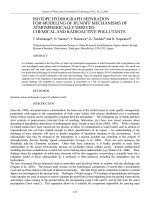
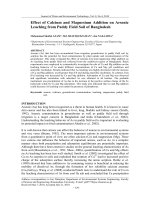
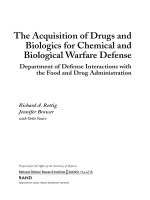
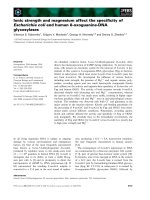

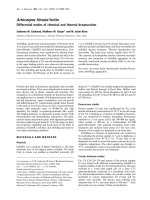

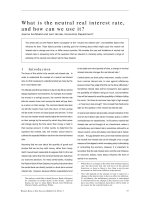
![Chemical and functional components in different parts of rough rice (oryza sativa l[1] ) beforeandaftergermination](https://media.store123doc.com/images/document/14/rc/qa/medium_qab1394872940.jpg)
